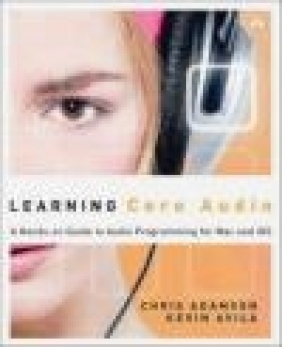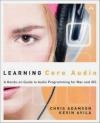Learning Core Audio
Kevin Avila, Chris Adamson
Learning Core Audio
Kevin Avila, Chris Adamson
- Producent: Addison Wesley Publishing Company
- Rok produkcji: 2012
- ISBN: 9780321636843
- Ilość stron: 336
- Oprawa: Miękka
Niedostępna
Opis: Learning Core Audio - Kevin Avila, Chris Adamson
Audio can affect the human brain in the most powerful and profound ways. Using Apple's Core Audio, you can leverage all that power in your own Mac and iOS software, implementing features ranging from audio capture to real-time effects, MP3 playback to virtual instruments, web radio to VoIP support. The most sophisticated audio programming system ever created, Core Audio is not simple. In Learning Core Audio, top Mac programming author Chris Adamson and legendary Core Audio expert Kevin Avila fully explain this challenging framework, enabling experienced Mac or iOS programmers to make the most of it. In plain language, Adamson and Avila explain what Core Audio can do, how it works, and how it builds on the natural phenomena of sound and the human language of audio. Next, using crystal-clear code examples, they guide you through recording, playback, format conversion, Audio Units, 3D audio MIDI connectivity, and overcoming unique challenges of Core Audio programming for iOS. Coverage includes: mastering Core Audio's surprising style and conventions; recording and playback with Audio Queue; synthesizing audio; perform effects on audio streams; capturing from the mic; mixing multiple streams; managing file streams; converting formats; creating 3D positional audio; using Core MIDI on the Mac; leveraging your Cocoa and Objective-C expertise in Core Audio's C-based environment, and much more. When you've mastered the "black arts" of Core Audio, you can do some serious magic. This book will transform you from an acolyte into a true Core Audio wizard.About the Authors xiii Foreword by Mike Lee xv Introduction 1 Audience for This Book 2 What You Need to Know 3 Looking Up Documentation 3 How This Book Is Organized 5 About the Sample Code 9 PART I: UNDERSTANDING CORE AUDIO Chapter 1 Overview of Core Audio 13 The Core Audio Frameworks 14 Core Audio Conventions 15 Your First Core Audio Application 16 Running the Example 19 Core Audio Properties 22 Summary 23 Chapter 2 The Story of Sound 25 Making Waves 25 Digital Audio 27 DIY Samples 32 Buffers 40 Audio Formats 40 Summary 41 Chapter 3 Audio Processing with Core Audio 43 Audio Data Formats 43 Example: Figuring Out Formats 46 Canonical Formats 51 Processing Audio with Audio Units 53 The Pull Model 55 Summary 55 PART II: BASIC AUDIO Chapter 4 Recording 59 All About Audio Queues 59 Building a Recorder 60 A CheckError() Function 63 Creating and Using the Audio Queue 64 Utility Functions for the Audio Queue 71 The Recording Audio Queue Callback 75 Summary 78 Chapter 5 Playback 81 Defining the Playback Application 81 Setting Up a File-Playing Audio Queue 83 Setting Up the Playback Buffers 85 Starting the Playback Queue 88 Playback Utility Functions 89 Handling the Magic Cookie 89 Calculating Buffer Size and Expected Packet Count 90 The Playback Audio Queue Callback 91 Features and Limits of Queue-Based Playback 94 Summary 95 Chapter 6 Conversion 97 The afconvert Utility 97 Using Audio Converter Services 100 Setting Up Files for Conversion 102 Calling Audio Converter Services 105 Implementing the Converter Callback 109 Converting with Extended Audio File Services 112 Reading and Converting with Extended Audio Files 116 Summary 118 PART III: ADVANCED AUDIO Chapter 7 Audio Units: Generators, Effects, and Rendering 123 Where the Magic Happens 123 How Audio Units Work 124 Sizing Up the Audio Units 126 Your First Audio Units 129 Building the main() Function 131 Creating an Audio Unit Graph 133 Setting Up the File Player Audio Unit 137 Speech and Effects with Audio Units 141 Building Blocks of the Speech Synthesis Graph 142 Creating a Speech Synthesis AUGraph 144 Setting Up a Speech Synthesizer 146 Adding Effects 147 Adding Your Code to the Audio Rendering Process 150 The Audio Unit Render Cycle 150 A Custom Rendering Example 151 Creating and Connecting Audio Units 154 The Render Callback Function 155 Summary 160 Chapter 8 Audio Units: Input and Mixing 161 Working with I/O Input 161 Connecting Input and Output Units 164 Creating an AUHAL Unit for Input 168 Writing the Input Callback 176 Building an AUGraph to Play Samples from a CARingBuffer 178 Writing the Play-Through App's Render Callback 181 Running the Play-Through Example 182 Mixing 183 Summary 189 Chapter 9 Positional Sound 191 Sound in Space 191 The OpenAL API 193 Putting a Sound in Space 196 Setting Up the Example 197 Using OpenAL Objects 200 Animating the Source's Position 205 Loading Samples for an OpenAL Buffer 206 Streaming Audio in OpenAL 210 Setting Up the OpenAL Streaming Example 210 Setting Up an ExtAudioFile for Streaming 215 Refilling the OpenAL Buffers 217 Summary 220 PART IV: ADDITIONAL TOPICS Chapter 10 Core Audio on iOS 223 Is That Core Audio in Your Pocket? 223 Playing Nicely with Others: Audio Session Services 224 An Audio Session Example 227 Setting Up the App 227 Initializing the Audio Session and Audio Queue 231 The Tone Generator Method 234 Handling iOS Interruptions 236 Audio Units on iOS 238 Building an Audio Pass-Through App with the iOS RemoteIO Unit 239 Setting Up the Pass-Through Example 241 Setting Up the RemoteIO Audio Unit for Capture and Play-Out 244 The RemoteIO Render Callback 249 Other iOS Audio Tricks 253 Remote Control on iOS 253 IOS Hardware Hazards 254 Summary 254 Chapter 11 Core MIDI 257 MIDI Concepts 257 Core MIDI 258 Core MIDI Architecture 258 Core MIDI Terminology 258 Core MIDI Properties 260 MIDI Messages 260 Instrument Units 261 Building a Simple MIDI Synthesizer 262 Connecting to MIDI 265 Handling MIDI Notifications and Events 267 Playing Your AUGraph 269 Creating MIDI Events 269 Setting Up the MIDIWifiSource Example 269 Setting Up MIDI over Wi-Fi 271 Sending MIDI Messages 273 Setting Up Your Mac to Receive Wi-Fi MIDI Data 275 Summary: MIDI Mastery ... but Mobility? 277 Chapter 12 Coda 279 Still More Core Audio 279 Next Steps 280 Digital Signal Processing 280 Lion and iOS 5 281 AUSampler 281 Core Audio on iOS 5 285 The Core Audio Community 286 Summary: Sounds Good 287 Index 289
Szczegóły: Learning Core Audio - Kevin Avila, Chris Adamson
Tytuł: Learning Core Audio
Autor: Kevin Avila, Chris Adamson
Producent: Addison Wesley Publishing Company
ISBN: 9780321636843
Rok produkcji: 2012
Ilość stron: 336
Oprawa: Miękka
Waga: 0.5 kg


















